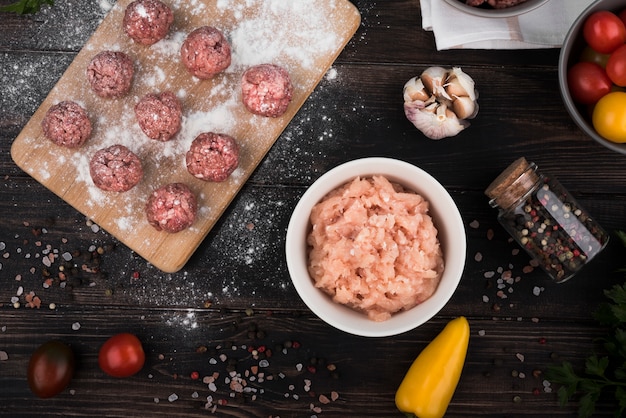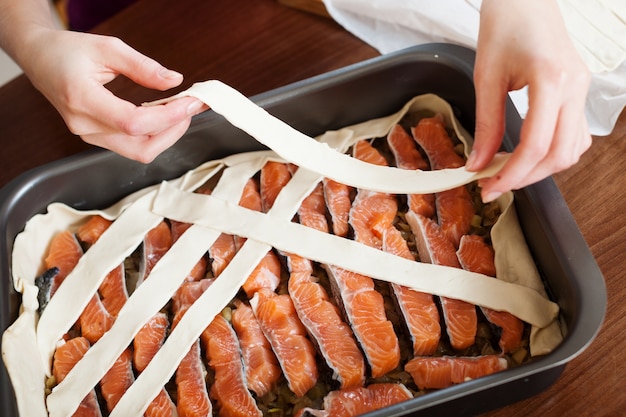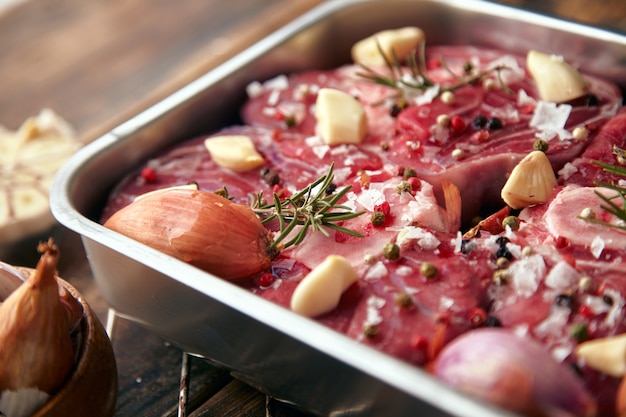(Part 1) Choosing the Right Ham

1. Bone-in vs. Boneless: A Matter of Taste and Convenience
Bone-in: These hams have a more traditional flavour and hold their shape better. You'll find that the bone adds a bit of extra depth and richness to the flavour, and it also helps to keep the meat moist. They're often a bit more economical, too. Boneless: These are pre-sliced and ready to carve, making them a real time-saver. They cook faster than bone-in hams and are perfect if you're looking for a convenient option. Personally, I usually go for a bone-in ham. I love the traditional flavour and the beautiful presentation when it's carved. But if I'm short on time or looking for something easier, boneless is the way to go.2. Cured vs. Uncured: Understanding Flavour Profiles
Cured: This is the most common type of ham, and it's usually smoked, giving it a distinctive flavour. The curing process involves using salt, sugar, and sometimes nitrates or nitrites to preserve the meat and give it a pink colour. Uncured: These hams are made with natural ingredients and don't contain nitrates or nitrites. They're often called "country ham" and tend to be drier and saltier than cured hams. They have a more intense flavour that some people really enjoy. For a classic ham flavour, go for the cured option. You'll find a wide variety of smoked and unsmoked cured hams, so you can choose based on your preference.3. Fresh vs. Pre-cooked: Convenience or Flexibility?
Fresh: These hams need to be cooked thoroughly before eating. They're a blank canvas, so you can cook them in a variety of ways and experiment with different flavours. Pre-cooked: These hams have already been cooked, so they just need to be reheated. They're super convenient and perfect for those looking for a quick and easy meal. If you're short on time, pre-cooked ham is the way to go. It's also a great option for a last-minute dinner party.(Part 2) Understanding cooking time: A Guide to Timing Perfection

1. Cooking Method: Choosing the Right Technique
Oven: This is the traditional method, and it's my go-to for a delicious and impressive ham. It allows for a beautiful golden crust and a rich, even cook. slow cooker: Perfect for a tender and juicy ham, especially if you want to glaze it. The slow and gentle cooking process ensures that the meat stays moist and flavorful. instant pot: A quick and easy option that delivers great results. It's perfect for busy weeknights or when you need to get dinner on the table quickly.2. Ham Type: Bone-in vs. Boneless
Bone-in: This type will require more cooking time compared to boneless. The bone takes longer to heat through, so you'll need to adjust your cooking time accordingly. Boneless: boneless hams cook more quickly and need less time overall. The absence of the bone allows for faster heat transfer, leading to quicker cooking times.3. Ham Weight: Adjusting for Size
A 9-pound ham will take longer to cook than a smaller one. The heavier the ham, the longer it will need to cook to reach the desired internal temperature.(Part 3) Cooking a 9-Pound Ham in the Oven: A Traditional Approach

1. Prepping the Ham: Setting the Stage for Success
Preheat your oven to 325°F (160°C). This temperature ensures even cooking and prevents the ham from drying out. Remove the ham from its packaging and place it in a roasting pan. A roasting pan is the ideal choice because it allows for even heat distribution and prevents the ham from sticking. Add about ?? cup of water to the bottom of the pan. This creates steam that helps to keep the ham moist during cooking.2. Scoring and Glazing: Creating Flavor and Beauty
Score the ham. This is an important step for several reasons. It helps to create a beautiful crust and allows for better flavour penetration. You can create a diamond pattern or just make parallel cuts, about 1/2-inch deep, across the fat. Create a glaze using brown sugar, honey, mustard, or any other combination you like. There are endless glaze options, so let your creativity run wild. Brush the glaze liberally over the ham, coating it evenly.3. Cooking Time: A Calculation for Perfection
Bone-in Ham: A 9-pound bone-in ham will need about 15-20 minutes per pound at 325°F. This means it will take around 2 hours and 15 minutes to 2 hours and 45 minutes. Boneless Ham: A 9-pound boneless ham will need about 12-15 minutes per pound at 325°F. This translates to 1 hour and 48 minutes to 2 hours and 15 minutes of cooking time.4. Checking for Doneness: Ensuring Safety and Quality
meat thermometer: The best way to ensure your ham is cooked through is with a meat thermometer. Insert it into the thickest part of the ham, avoiding bone. The internal temperature should reach 145°F (63°C). This temperature ensures that the ham is safe to eat and that it's cooked to the perfect degree of doneness. Juices: If the ham is done, the juices should run clear when pierced with a fork. This is a good visual indicator, but it's always best to use a meat thermometer for accuracy.5. Resting: Unlocking Maximum Tenderness
Let the ham rest for at least 15 minutes before carving. This allows the juices to redistribute, resulting in a juicier, more tender ham. Think of it as a moment of relaxation for the ham before it's sliced and served.(Part 4) slow cooker ham: Simple and Delicious
If you want a set-it-and-forget-it approach, the slow cooker is a fantastic choice. It's perfect for those busy days when you need a hands-off method that delivers delicious results.1. Prepping the Ham: Preparing for Slow-Cooking Success
Score the ham and apply your glaze. You can use the same glazing techniques as you would for oven-cooking, creating a flavorful crust. Place the ham in the slow cooker. Make sure the ham fits comfortably inside the slow cooker. If it's too large, you can cut it in half.2. Cooking Time: Adjusting for Low and High Settings
Bone-in Ham: A 9-pound bone-in ham will take about 6-8 hours on low or 3-4 hours on high. The longer cooking time on low will result in a more tender ham. Boneless Ham: A 9-pound boneless ham will take about 4-6 hours on low or 2-3 hours on high. Boneless ham cooks faster, so you'll need to adjust the cooking time accordingly.3. Checking for Doneness: Ensuring Safety and Perfection
Meat Thermometer: Use a meat thermometer to ensure the internal temperature reaches 145°F (63°C). This is crucial to ensure that the ham is cooked through and safe to eat.4. Resting: Allowing for Juicy Results
Let the ham rest for 15 minutes before carving. This allows the juices to redistribute, ensuring a juicier, more flavorful ham.(Part 5) Instant Pot Ham: Speedy and Convenient
The Instant Pot is a game-changer for busy cooks. It's a quick and easy way to cook a delicious ham.1. Prepping the Ham: Setting the Stage for Instant Pot Success
Score the ham and apply your glaze. You can use the same glazing techniques as you would for oven-cooking or slow-cooking. Place the ham in the Instant Pot. Make sure it fits comfortably. You can cut it in half if needed. Add about ?? cup of water to the Instant Pot. This helps to create steam and prevent the ham from drying out.2. Cooking Time: A Quick and Efficient Method
Bone-in Ham: A 9-pound bone-in ham will take about 90-120 minutes on high pressure. Boneless Ham: A 9-pound boneless ham will take about 60-90 minutes on high pressure.3. Checking for Doneness: Ensuring Safety and Perfection
Meat Thermometer: Use a meat thermometer to ensure the internal temperature reaches 145°F (63°C). This is crucial to ensure the ham is cooked through.4. Resting: Allowing for Juicy Results
Let the ham rest for 15 minutes before carving. This allows the juices to redistribute, ensuring a moist and flavorful ham.(Part 6) Glazing and Serving Ideas: Turning a Ham into a Feast
Once your ham is cooked, it's time to get creative!1. Glazing Options: Endless Flavour Possibilities
Classic honey-mustard glaze: Combine honey, Dijon mustard, and a touch of brown sugar for a sweet and tangy glaze. Maple-brown sugar glaze: The combination of maple syrup and brown sugar creates a rich, caramelized glaze. Spicy pineapple glaze: For a bit of a kick, mix pineapple juice, brown sugar, and hot pepper flakes. Bourbon Glaze: If you're feeling fancy, try a bourbon-based glaze with brown sugar and a hint of vanilla.2. Serving Suggestions: Completing the Culinary Experience
Sides: Serve your ham with classic sides like mashed potatoes, sweet potato casserole, green bean casserole, or macaroni and cheese. Salads: A fresh salad can add a nice contrast to the rich flavour of the ham. Bread: A crusty bread roll is the perfect accompaniment for soaking up the delicious juices.(Part 7) Storage and Leftovers: Making the Most of Your Ham
You've cooked a beautiful ham. Now, what do you do with it?1. Storage: Preserving the Flavour and Quality
Refrigerator: Store cooked ham in the refrigerator for up to 4 days. Wrap it tightly in plastic wrap or aluminum foil to prevent drying out. Freezer: To freeze cooked ham, wrap it tightly in plastic wrap and then in foil. It can be frozen for up to 2 months. Thaw it in the refrigerator before reheating.2. Leftovers: Turning Ham into Delicious Creations
Sandwiches: Slice the ham and make delicious ham sandwiches. Add your favourite toppings for a satisfying and flavorful meal. Salads: Dice the ham and add it to your favourite salads for a boost of flavour and protein. Soups: cook ham bones and leftover ham in a slow cooker for a hearty soup. This is a great way to use up the ham bones and create a flavorful broth. Breakfast: Fry up leftover ham with eggs for a satisfying breakfast. It's a quick and easy way to use up leftovers and enjoy a delicious meal.(Part 8) Frequently Asked Questions
1. What does a 9-pound ham yield?
A 9-pound ham will yield about 10-12 servings, depending on the size of the portions. You can adjust the amount of servings based on your guests' appetites.
2. Can I cook a 9-pound ham in a smaller roasting pan?
It's best to use a roasting pan that's large enough to hold the ham comfortably. If you use a smaller pan, the ham might not cook evenly and could stick to the pan. It's better to use a pan that's the right size to ensure even cooking.
3. Can I cook a 9-pound ham in a pressure cooker?
Yes, you can cook a ham in a pressure cooker, but it's important to follow the manufacturer's instructions carefully. A 9-pound ham will likely require a longer cooking time in a pressure cooker than in an oven or slow cooker. It's also important to adjust the cooking time based on the size and type of ham.
4. How do I tell if a pre-cooked ham is done?
Pre-cooked hams only need to be reheated, so you don't need to worry about checking for doneness. Just make sure the internal temperature reaches 140°F (60°C). This ensures that the ham is heated through and safe to eat.
5. What are some alternative methods to cooking a ham?
Besides oven, slow cooker, and Instant Pot, you can also grill, smoke, or even braise a ham. Each method offers a unique flavour and texture. Grilling can give the ham a smoky flavour, while smoking adds a rich, intense flavor. Braising creates a tender and flavorful ham.
(Part 9) A Final Word
Cooking a 9-pound ham might seem daunting at first, but it's actually quite simple. Just follow these guidelines, and you'll be rewarded with a delicious and satisfying meal. Remember, the most important thing is to have fun and enjoy the process. Bon appétit!Everyone is watching

Prime Rib Roast Cooking Time Chart: Per Pound Guide
Cooking TipsPrime rib roast. Just the name conjures images of lavish dinners, crackling fires, and hearty laughter. It’s ...

How Long to Bake Potatoes in the Oven (Perfect Every Time)
Cooking TipsBaked potatoes are a staple in my kitchen. They're incredibly versatile, delicious, and surprisingly easy to m...

Perfect Rice Every Time: The Ultimate Guide to Cooking Rice
Cooking TipsAs a self-proclaimed foodie, I've always been a bit obsessed with rice. It's the foundation of countless cuisi...

The Ultimate Guide to Cooking Asparagus: Tips, Techniques, and Recipes
Cooking TipsAsparagus. The mere mention of this spring delicacy conjures up images of vibrant green spears, crisp and burs...

Ultimate Guide to Cooking the Perfect Thanksgiving Turkey
Cooking TipsThanksgiving. Just the word conjures up images of overflowing tables laden with delicious food, the scent of r...
